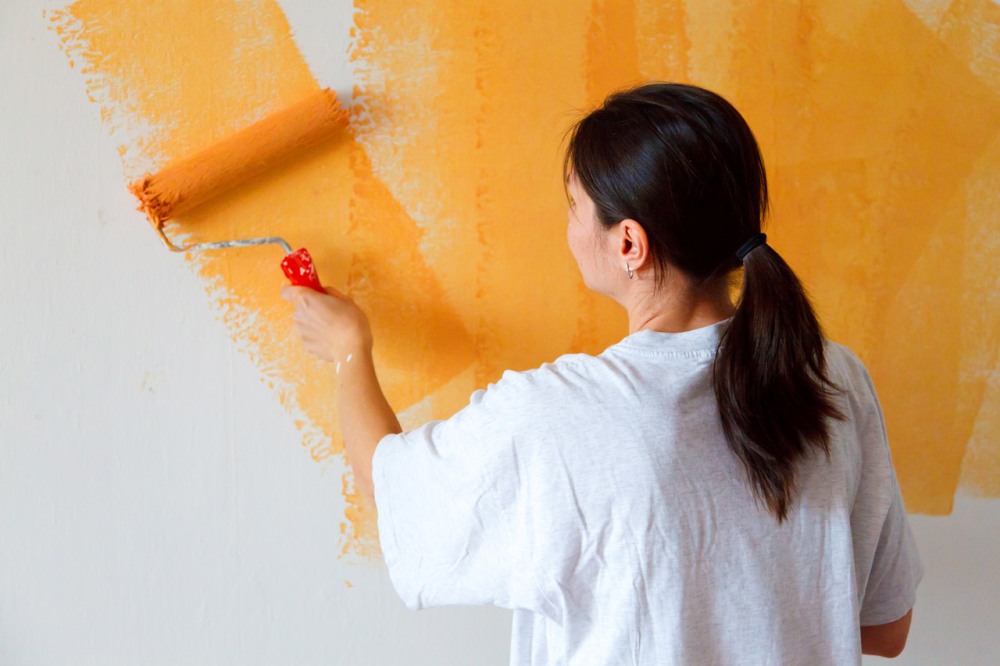How To Paint A Room: A Pro Guide

painting wall
If it’s high time a certain room in your home had a makeover, then paint is one of the simplest and cheapest ways to make a big difference. With an hour or so of your time, a tub or two of paint, and the right tools, you can create a stylish new look in your bathroom, kitchen, bedroom or hallway! Here are some simple tips to help make sure you get a great finish.
What you’ll need
Paint
Roller and tray
Brushes
Masking tape
Plastic sheeting, canvas sheets or old bed sheets
Potentially: Plaster, primer, air tight container (if using more than one tin)
Preparation makes perfect
Although it might be tempting to start painting the second you get the tin out, it’s not wise to dive right in. You’ll end up avoiding problems if you spend a little time prepping before you begin! (I didn’t intend for that to rhyme, but I’m happy that it did.)
1) Cover over furniture and flooring
Firstly, protect your possessions from flying flecks of paint! Remove whatever you can from the room – laptops, devices, etc. Pile the remaining furniture etc in the middle of the room, away from any walls you’ll be painting, and cover it over with plastic sheeting.
Next, cover over the floor, if you don’t want it to become speckled with paint. Use an old bed sheet or some other canvas sheeting for the floor – plastic sheeting is very slippery so it’s not a great option for a floor space, particularly when you’re walking across it with a tray of paint.
2) Protect fixtures and fittings
Go to your fuse box and turn off the circuit breakers in the room you’re painting (if you’re not 100% sure what you’re doing, ask someone who is). Then, it’ll be safe to remove the socket and light-switch covers. Cover the wires over with some tape.
Carrier bags and elastic bands work wonders for protecting door handles!
3) A sound, smooth surface
If your walls are lined with peeling wallpaper, strip it off! You want to work to a nice, sound, level surface. Check out our guide: How to remove wallpaper
Likewise, remove any former flaking paint by picking at the loose parts with a scraper.
Patch up any small holes in the walls or floors with plaster or polyfilla! Use a trowel or scraper to work it into the hole, leave it to dry, and then sand it smooth against the surface.
If your walls are riddled with holes, fill them in and then apply some lining paper for a nice, even surface.
4) Banishing the old colour
If you’re having a drastic colour change, i.e, from a vibrant red to a pale grey, give the walls a coating of primer before cracking on with the emulsion, otherwise the colour below might shine through.
5) Order the right amount
There’s nothing worse than being all kitted up in your messy overalls, paint brush or roller in hand, 90% into the job, and then running out of paint! Make sure you’ve got the right amount for the area you’re painting.
With emulsion, which is most probably the paint type you’ll be using on your walls, a rough coverage guide is 12 Sqm per litre per coat.
Need a hand working out your surface areas? Check out our handy guide: How to measure your room.
6) Boxing: How to beat batch variation with paint
Like with most decorating materials, paint can vary slightly in shade from bucket to bucket. This is called batch variation. There’s an easy trick to beat this, though, if you’re using more than one bucket of [supposedly] the same colour! It’s calling ‘boxing’…
Get yourself a suitably sized container (preferably one with an air tight lid if you’re not doing all your painting in one day). Pour all of the buckets of the same-colour paint into this one container, and give it a good stir! This will blend any shade differences into one universal tone. Once mixed, you’re ready to paint!
Now it’s time to start painting…

How to Paint Your Home: Starting from the top
Since paint has a tendency to drip, it’s always a good idea to start from the top of the room and work downwards. So, if you’re giving your ceiling a refreshing new coat, that’s where you’ll start! And then you’ll move down to the walls and, eventually, the skirting boards or trims!
How to paint a ceiling
Starting with your ceiling, then, here are 4 easy steps…
1) Use a brush around the edges
On your ceiling, start off by painting around the edges of the surface with a brush; this gives you much more control along those delicate lines! Use a stable stepladder and, if possible, get somebody to hold it still!
Top tip: Only dip around a third of the brush into the paint, tap it on the sides of the tin or container, and then hold the brush like a pencil and use smooth strokes! This will prevent any nasty globs or drips.
2) It’s roller time
Once the edges are complete, you can switch over to the roller! Long, extendable handles are available for from-the-ground painting.
Dip the edge of the roller cover into the paint – don’t submerge it – and then run it along the tray’s bed to spread the paint evenly. Rolling slowly will help you to avoid getting showered in paint.
3) Assessing the coat
When you’ve finished, wait for it to dry, and then assess whether it needs another coat. Usually emulsion requires two coats. Once you’re happy that it’s finished, move onto the next step!
4) Masking
Apply some masking tape across the edges of the ceiling, leaving the tops of the walls bare. Now it’s time to move down to those walls!

How to paint a wall
Now that the ceiling’s done, you can progress down to the wall areas…
1) Edging
Once again, you’ll start by painting around the edges of your wall. Work up against the masking tape you’ve put in place on your ceiling.
Work around all four edges of your wall. Along the bottom, where your skirting board is, it doesn’t matter too much if you get the occassional bit on it, as you’ll be painting that next, but try not to cake it in paint as it might effect the shape of the surface.
Once your edges are painted, move on to the roller!
2) Roller the wall
Like with the ceiling, don’t submerge your roller in the paint – dip one edge, and then use the tray’s bed to spread it evenly across the roller’s edge.
Then, starting from your painted edge, work across the wall in zig-zag motions. Turn the roller sideways to get extra close to the ceiling and skirting boards.
Lightly roll down the areas you’ve painted to help mop up any excess, which will prevent any unsightly drips.
Top tip: Don’t apply extra pressure to the roller to squeeze more paint out, just dip it back in the paint tray!
Paint one wall, one coat at a time. Two coats is usually the magic number. If you’re waiting for a coat to dry, or you’re taking a break, wrap up your roller and tray with clingfilm – it’ll help to keep the paint dry and the tools ready for action when you come back.
3) A matter of masking tape
When the wall is dry, and you’ve given it all its coats, remove the masking tape on the ceiling. Then, apply some masking tape along the bottom of the wall, above the skirting board or trim!

How to paint a skirting board
If you’re painting a wooden skirting board, emulsion would probably flake off, so you’ll want to upgrade to gloss!
Give the tin a mix, dip the brush a third of the way into the paint, tape off the excess and apply smooth strokes to the skirting; working into the masking tape on the wall.
Once it’s dry, take off the masking tape. You might need to use a craft knife to cut through the new layer of paint, to help free it.
Finishing up!
Now that the painting’s all finished, it’s time to set the room back to normal! Firstly, uncover all the door handles and remove all the cover sheets. Secondly, screw your light switch and plug sockets back in place, and turn the electricity back on.
Then it’s simply a case of more all the furniture and accessories back to exactly where you want them!
Once that’s done, kick back, relax, and enjoy your new room. And be thankful you didn’t make a mess of that paint job.

Whilst you’re giving your home a fresh lick of paint, you should tune in to our Ultimate Decorating Playlist!



